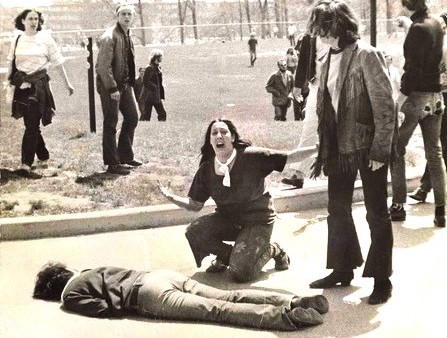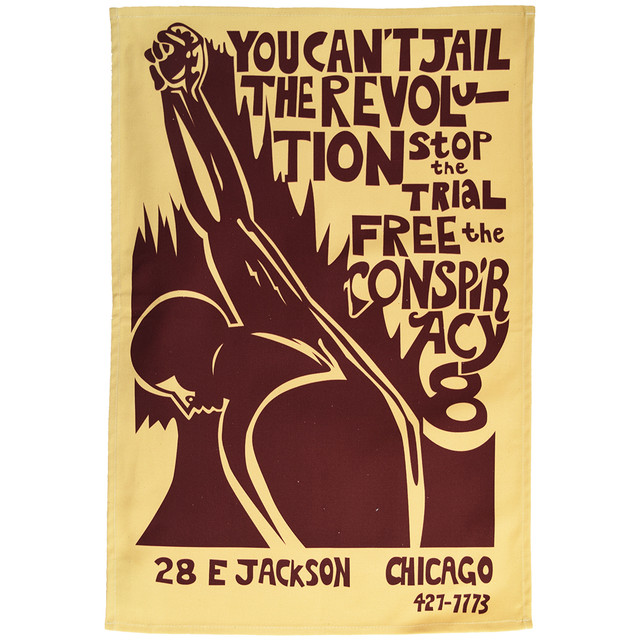They Can't Kill Us All: The Kent State Massacre of 1970
Posted by Pete on May 4th 2024

On this day in 1970, the National Guard opened fire on students protesting the Vietnam War
The U.S. government was wrong to think that its war in Vietnam wouldn’t cause trouble at home.
As American troop numbers in Southeast Asia were radically increased by Lyndon Johnson in the 1960s, a powerful
anti-war movement began to develop inside the United States.
The government, as always, did all it could to silence activists and shut down protests.
Like all movements for freedom and justice, the fight for peace in Vietnam wasn’t going to be an easy one.
In 1969, eight anti-war activists were put on trial for conspiring to incite riots that took place at the 1968 Democratic National Convention in Chicago
See the Chicago Seven (Conspiracy Eight) tea towel
After the draft was introduced in 1964, the threat of conscription turned thousands of ordinary Americans against the war.
And when it became obvious that it was mostly black and working-class men being sent to die for the sake of U.S. global supremacy, objections to the war became stronger.
The black freedom struggle in the U.S., including activists like
Muhammad Ali, was a key source of peace activism. In 1968, shortly before his assassination, Martin Luther King came out publicly against the war.
On university campuses in the U.S. too there was massive opposition to the U.S. invasion of Vietnam.
The resources of critical thinking nurtured by higher education empowered students to identify and denounce the imperialist nature of the U.S. military presence in Southeast Asia.
There was widespread solidarity with the Vietnamese struggle for independence which, after enduring and defeating first the French empire, then Japan, then France again, was now facing down the United States.
In 1966, Ali refused to be drafted into the military owing to his opposition to the Vietnam War, and was found guilty of draft evasion and stripped of his boxing titles
See the Muhammad Ali tea towel
By 1970, the anti-war movement had become a powerful force in U.S. society.
It was in April of that year that
Richard Nixon, who had been elected President in 1968 on the promise to end the war in Vietnam, announced that he had in fact illegally expanded the conflict by invading the neutral state of Cambodia.
This was the immediate backdrop for the Kent State University Massacre of 4 May 1970, when four unarmed students were shot dead on their own campus by the Ohio National Guard for being present at a peaceful demonstration against the Vietnam War.
In response to Nixon’s confession that his government had invaded Cambodia, a protest of 500 Kent State students was immediately held on the University Commons.
Another protest against the new war in Cambodia was planned for three days later, on 4 May.
During the next few nights, tensions in Kent quickly increased.
Anti-war protestors, both belonging to the University and independent of it, clashed with violent police.
Police were now routinely invading the Kent State campus, and on 2 May the Mayor of Kent easily convinced the belligerent Governor of Ohio, Jim Rhodes, to deploy the National Guard.
The conservative forces of ‘law and order’ (which often meant, in practice, unconstitutional violence) began slandering peaceful anti-war protestors at Kent State as “un-American” dissidents, echoing the reactionary rhetoric of the Nixon administration in Washington.
Many of history's most significant protest movements have been student-run - like the White Rose Movement at the University of Munich
These tensions boiled over on Monday, 4 May, 1970.
When 1,000 peaceful anti-war demonstrators gathered on the Kent State Commons, the National Guard ordered them to disperse immediately.
The students refused, standing by their democratic right to free speech. The Guardsmen then advanced on them, firing teargas.
But the soldiers weren’t only armed with teargas. Moments later, a group of them opened fire with live rounds.
Four students – Allison Krause (19), William Knox Schroeder (19), Jeffrey Glenn Miller (20), and Sandra Lee Scheuer (20) – were shot dead.
Eight others were wounded, with one of them paralysed.
The Kent State Massacre, for which the Nixon government was shamelessly unapologetic, was an act of barbarity and political repression more suited to a police state, not a democracy.
The massacre triggered a huge wave of solidarity strikes by students across the United States, covering 450 university campuses.
Students at New York University declared “They Can’t Kill Us All.”
And they were right.
The anti-war movement in the United States during the 1960s and 1970s was key to ending the brutal American invasion of Vietnam.
But whereas the movement itself was peaceful, its opponents were not.
Many anti-war activists, including MLK and the students at Kent State, were made to pay with their lives for supporting peace. Their legacies live on.



